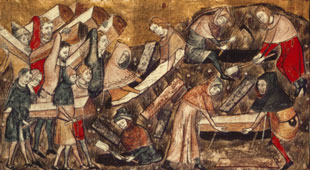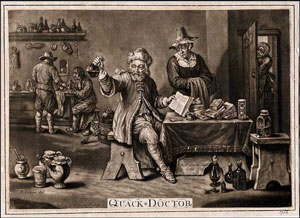Small Planet Communications, Inc. + 15 Union Street, Lawrence, MA 01840 + (978) 794-2201 + Contact







DID YOU KNOW?
The average life expectancy
of early colonial residents
was just 25 years.
AGUE: see MALARIA
APOPLEXY: stroke; sudden loss of consciousness due to lack of oxygen in the brain

Learn more about the history of the plague, how it is
spread, and its impact on world history.
BILIOUS FEVER: fever caused by liver disorder
BLACK DEATH: see BUBONIC PLAGUE
BLACK LUNG DISEASE: chronic lung disease from the prolonged breathing of coal dust
BRIGHT'S DISEASE: inflammation of the blood vessels in the kidneys
BUBONIC PLAGUE: a contagious, malignant disease most commonly characterized by headache, chills, and weakness; enlarged lymph nodes in the groin, neck, and armpits (buboes) are tender and painful; an overwhelming infection of the blood may cause death in three or four days, even before other symptoms appear; the bubonic plague is also called the "Black Death," named for the gangrene of the fingers, toes, and nose
CAMP FEVER: see TYPHUS FEVER
CATARRH: inflammation of the nose and throat which causes watery eyes and nose and increased mucous production
CHILBLAIN: an inflammatory swelling of the hands and feet caused by exposure to cold
CHLOROSIS: a disease in young women characterized by weakness and a greenish complexion; caused by iron deficiency or anemia
CHOREA: acute disturbance of the central nervous system characterized by involuntary muscular movements of the face and extremities; usually, but not always, a complication of rheumatic fever
CONGESTIVE FEVER: see MALARIA
CONSUMPTION: see TUBERCULOSIS
DID YOU KNOW?
Until the 19th century, most doctors did not
have a college education or need a special
certificate to practice medicine. In fact, until
the 18th century local barbers (also known
as barber-surgeons) would perform surgery,
dentistry, and provide haircuts. Learn more
about the history of barbers and their iconic
barber's pole.
DAY FEVER: an epidemic disease characterized by intense sweating; death often occurs in less than a day; also known as the sweating sickness
DIPHTHERIA: an infectious disease that usually affects the throat and upper respiratory system; characterized by the formation of a mucous membrane on the lining of the throat, causing difficulty in breathing and swallowing
DROPSY: see EDEMA
DYSENTERY: inflammation of body tissues resulting in body cavities producing a discharge of mucous and blood
DYSPEPSIA: a functional disease whose symptoms are triggered by eating; characteristics include upper abdominal pain, bloating, nausea, gas, and a feeling of fullness with a small intake of food
EDEMA: the swelling of soft body tissues caused by accumulation of excess fluids
EPILEPSY: a disease characterized by sudden loss of consciousness or convulsions; seizures are caused by a disorder in the central nervous system
FALLING SICKNESS: see EPILEPSY

Some colonists practiced quackery, meaning they
fooled ill people into believing they were being
cured while taking their money.
GOITER: a non-cancerous enlargement of the thyroid gland, visible as a swelling at the front of the neck; it is often associated with iodine deficiency
GOUT: an elevation of uric acid in the blood; characterized by kidney stones and painful inflammation of the joints
GRAVE'S DISEASE: over-activity of the thyroid gland
GREAT POX: see SYPHILIS
GREEN SICKNESS: see CHLOROSIS
JAUNDICE: a condition caused by high levels of bile in the blood; characterized by yellowness of the skin
LUMBAGO: a rheumatic pain in the loins and small of the back
LUNG FEVER: see PNEUMONIA
LUNG SICKNESS: see TUBERCULOSIS
MALARIA: an infectious, sometimes fatal disease spread by mosquitoes; symptoms include chills, fever, recurring headaches, muscle aches, vomiting, coughing, and jaundice
MILK SICKNESS: a form of poisoning caused by cows ingesting the leaves of the white snakeroot plant and passing along its toxin in their milk
PALSY: the loss or defect of the power of voluntary muscular motion in all or part of the body; paralysis
PLEURISY: inflammation of the membrane that covers the inside of the thorax, accompanied by fever, pain, and cough
PNEUMONIA: inflammation of the lungs; symptoms include fever, chills, coughing, and chest pain
PUERPERAL FEVER: high fever lasting more than 24 hours following the birth of a child
PUTRID FEVER: see TYPHUS FEVER

Learn more about common health practices
during the Revolutionary War era. View
Revolutionary War amputation tools.
RHEUMATISM: a general term describing painful muscles, joints, tendons, and bones
RICKETS: a disease of the skeletal system resulting from a deficiency of Vitamin D in the diet or from lack of exposure to sunlight
SCARLET FEVER: a disease caused by infection with a bacteria associated with strep throat; accompanied by a sore throat, fever, chills, vomiting, abdominal pain, and malaise
SCIATICA: pain in the lower back and behind the thighs; caused by a pinch in the sciatic nerve
SCURVY: a disorder caused by a Vitamin C deficiency; characterized by anemia, soft bleeding gums, and bumps under the skin; usually suffered by people living in confined areas or on a diet of salted meats without fresh fruits and vegetables
SEPTICEMIA: blood poisoning; symptoms include fever, chills, and exhaustion; treated with antibiotics
SMALLPOX: a contagious, often fatal disease caused by the variola virus, and characterized by a rash and small pus-filled lesions (or pocks) that form during an infection; it is spread by the fluid in the pocks on an infected person's skin or by droplets of their saliva
ST. VITUS' DANCE: see CHOREA
SYPHILIS: a highly contagious disease, typically transmitted sexually, consisting of three stages: formation of a chancre, or a painless ulcer; hair loss, white patches, and rash; damage to the brain and heart
Read more about tuberculosis. Then
take this quiz to test your knowledge
about this deadly disease.
TUBERCULOSIS: a highly contagious bacterial infection that typically develops in the lungs and spreads throughout the body
TYPHUS FEVER: an acute, infectious disease that is typically spread by fleas, lice, and mites and is characterized by a high fever, headache, and rash
ULCERATION: skin or tissue erosion caused by an ulcer
WHOOPING COUGH: a highly contagious disease of the respiratory system usually affecting children; characterized by runny eyes and nose followed by severe spasms of coughing
WINTER FEVER: see PNEUMONIA
To learn more about
a disease not listed
on this page, try
searching an online
dictionary of medical
terms.
YELLOW FEVER: an acute viral disease causing high fever and kidney and liver damage; death of liver cells results in jaundice; often spread by mosquitoes
Also see Smallpox.
Diseases | Bibliography
- Centers for Disease Control and Prevention (CDC). “History of the Plague.” Accessed 5/30/19. https://www.cdc.gov/plague/history/index.html
- The Colonial Williamsburg Foundation. "That Quacking Sound in Colonial America." Accessed 5/30/19. http://www.history.org/Foundation/journal/Spring04/
quackery.cfm - Dictionary.net. "Online English Dictionary." Accessed 5/30/19. http://www.dictionary.net/
- Fenton Historical Society. “Old Medical Terms.” Accessed 5/30/19. http://fentonhistsoc.tripod.com/id121.html
- MedicineNet, Inc. "Medical Dictionary." Accessed 5/30/19. http://www.medterms.com/script/main/hp.asp
- Public Broadcasting Service (PBS). "Barbers and Surgeons Part Ways."
Accessed 5/30/19. http://www.pbs.org/kqed/demonbarber/bloodletting/
barbersandsurgeons.html
Diseases | Image Credits
- Burying Plague Victims of Tournai | Artist: Gilles de Muisit, 1349; EyeWitness to History.com
- Quack Doctor | Artist: Richard Purcell, c. 1736–1766; Colonial Williamsburg, courtesy of Lewis-Walpole Library, Yale University
- Medical Equipment from the Revolutionary War Era | Herbert Hoover Presidential Library and Museum
© 2020 Small Planet Communications, Inc. + Terms/Conditions + 15 Union Street, Lawrence, MA 01840 + (978) 794-2201 + planet@smplanet.com


